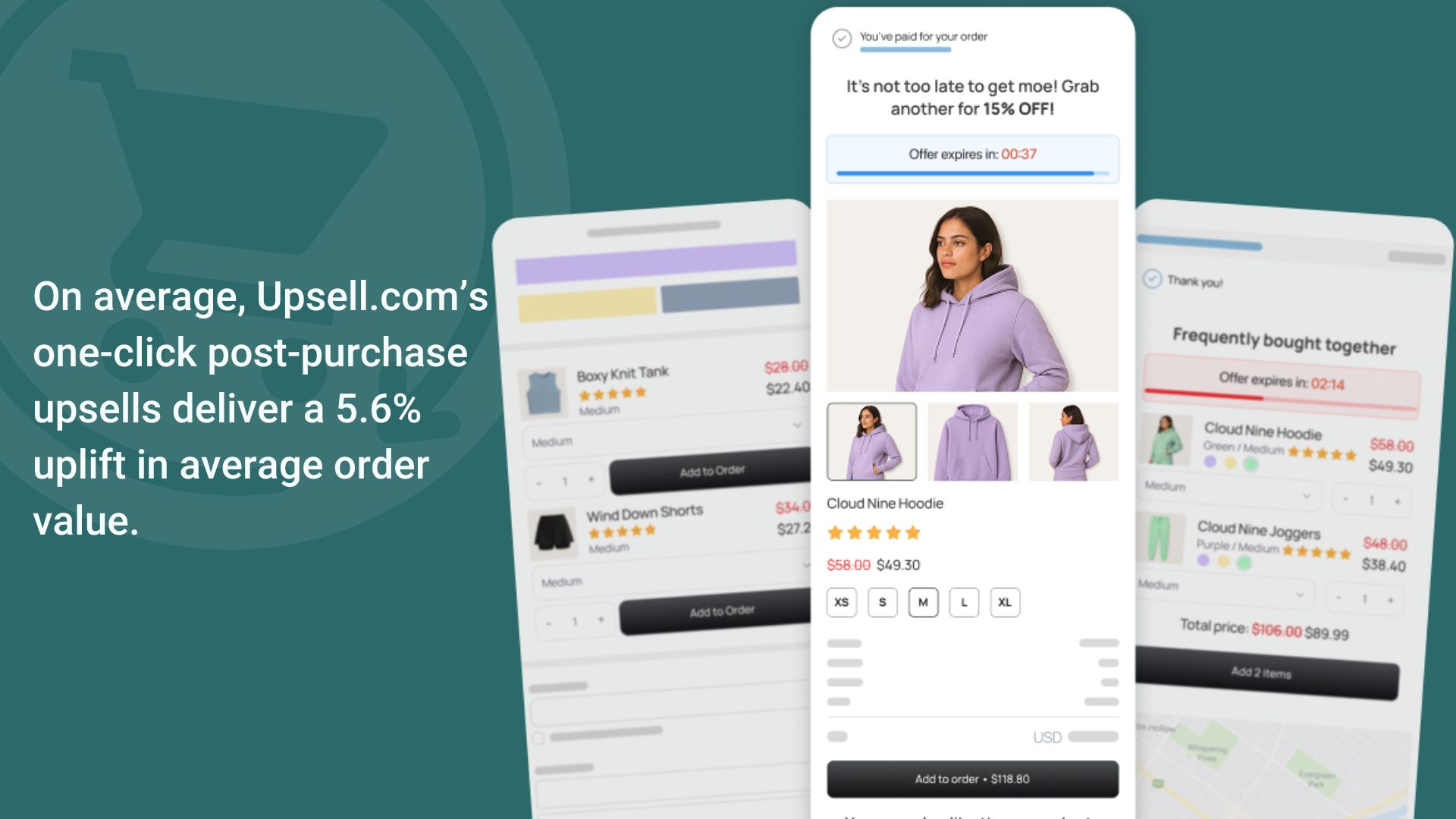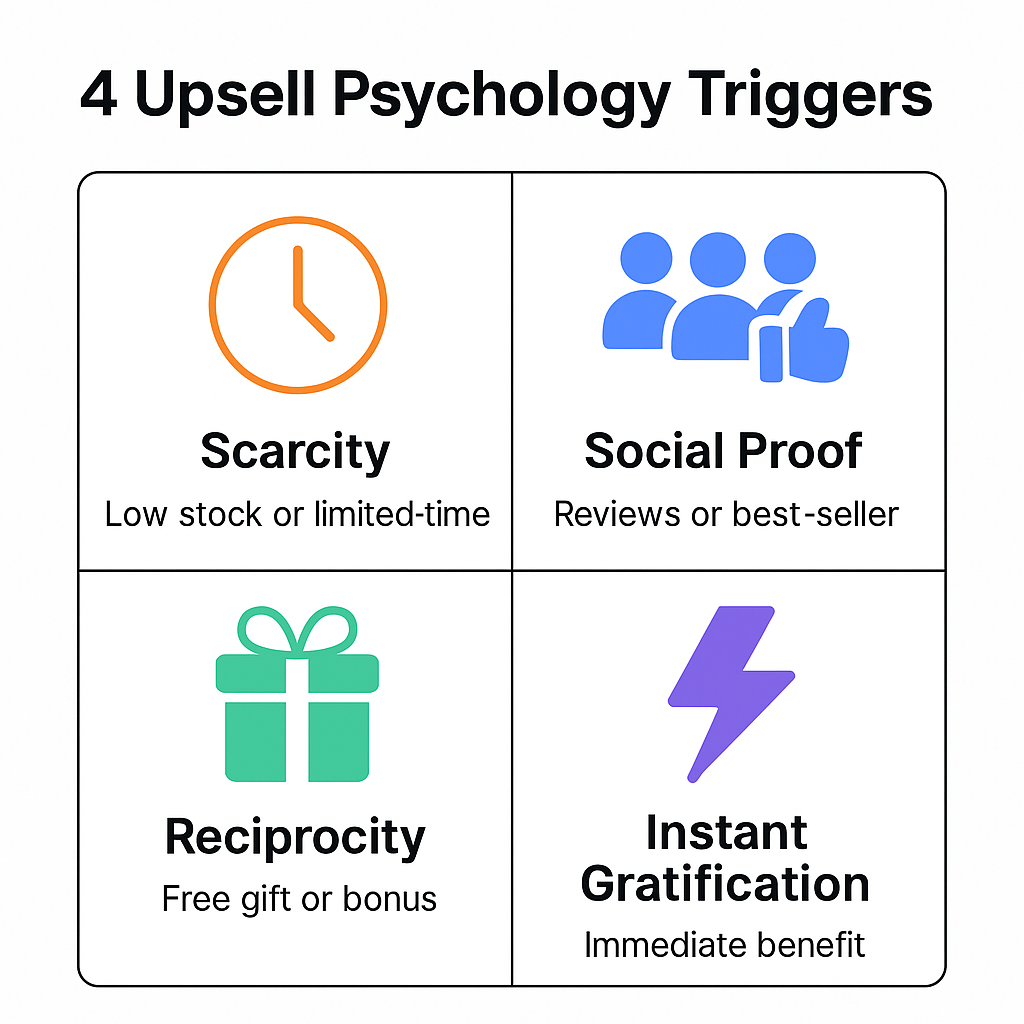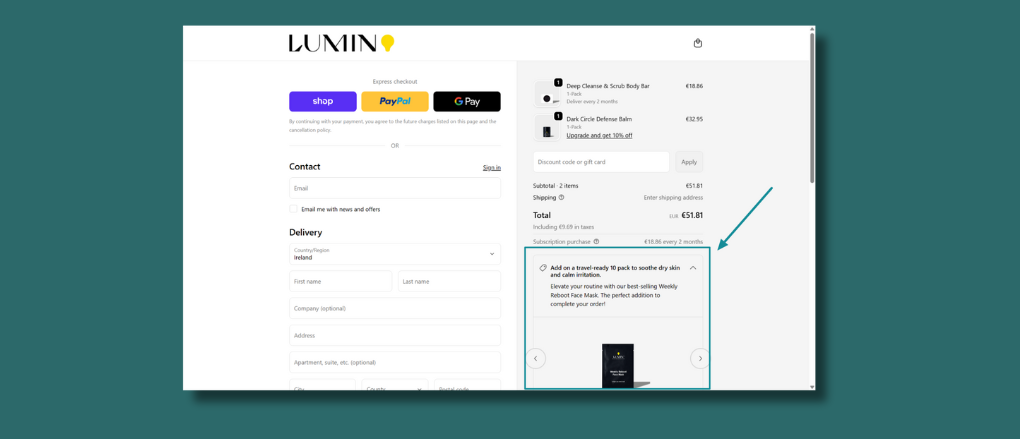How to Upsell a Product in 2026 (With Examples)
.jpg)
Upselling isn’t a nice-to-have, it’s a profit multiplier.
Data shows that upsells and cross-sells can account for 10-30% of total eCommerce revenue, yet most stores barely scratch the surface.
So let’s fix that.
In this guide, you’ll learn how to upsell a product effectively, with proven strategies from high-performing stores, psychological triggers that drive conversions, and a clear process to optimize every offer.
{{cool-component="/style"}}
What Is Product Upselling (and Why It Works)
Product upselling is the practice of suggesting a more expensive or complementary item to a customer who’s already in buying mode.
For example, when someone buys a $50 hoodie and you offer a premium version for $70, that’s an upsell.
Upselling works because you’re talking to people who already trust you. The hardest part, getting attention, is done. Now it’s about increasing the value of that relationship.
According to Shopify data, returning customers spend 67% more than new ones. So, instead of constantly chasing new buyers, upselling lets you maximize every existing transaction.
Upselling vs. Cross-Selling
Upselling & cross-selling are related. But they're not the same.
How to Upsell a Product on Shopify: 6 Proven Strategies
Ready to put upselling into action?
Here are six proven methods you can implement immediately, no coding required.
1. Use Post-Purchase Offers

Post-purchase upsells appear after checkout but before the thank-you page. This is one of the most powerful (and underused) spots to increase revenue.
Since the payment is already completed, the customer can add another product with one click, without re-entering details.
Example: a skincare brand offers “Add a travel-size serum for 25% off” right after purchase. The buyer feels rewarded, and you get an effortless boost in AOV.
2. Bundle Smart, Not Hard

Bundles work because they simplify decisions. Instead of choosing between products, customers say “yes” to a convenient package.
But here’s the catch: bundles must make sense.
Offer items that naturally complement each other, like a coffee maker with a bag of beans or a phone with a case.
Keep the savings clear: “Get all 3 for 15% off.”
Shopify’s native discount system makes it easy to create bundle codes, or you can automate it through third-party apps.
3. Leverage Order Bumps at Checkout

An order bump is a small upsell box placed right before checkout. Think of it as a “while you’re here” nudge.
Example:
“Add extended warranty for $9.99”
“Protect your order with shipping insurance”
“Add reusable gift wrapping for just $5”
The key is subtlety, don’t overwhelm the customer, but make the offer feel like a natural addition.
4. Create Personalized Product Recommendations
.jpg)
Personalization makes upsells feel helpful, not pushy.
Use browsing history, previous orders, or cart contents to recommend relevant products.
For instance:
- A buyer of running shoes sees matching socks or insoles.
- A pet owner buying dog food gets an offer for treats or toys.
Personalized recommendations convert up to 4x better than generic ones because they’re contextually aligned with the shopper’s intent.
5. Time-Limited Upsells with Urgency Triggers
.jpg)
Nothing drives action like urgency.
Add a countdown timer, limited-stock indicator, or “Only today: upgrade for 20% off” message. When used ethically, urgency helps customers make quicker decisions and increases conversions.
Example:
“Add our premium case in the next 10 minutes to unlock free express shipping.”
Just remember: fake scarcity kills trust. Be transparent and use real promotions tied to inventory or event timing.
6. Test A/B Offer Variations and Track AOV Lift
Never assume one upsell will work forever.
Test different products, copy, and price points.
Run split tests over a few weeks and measure impact on AOV (average order value) and conversion rate.
Example:
A fitness brand tested two post-purchase offers:
- Option A: “Add protein bars for $12”
- Option B: “Add a protein sampler pack for $15”
The sampler pack outperformed by 28% higher take-rate because it felt like added value.
The Psychology Behind High-Converting Upsells
Upselling works best when it taps into human psychology rather than just discounts.
Here are the key triggers to master:
- Commitment Bias: Once customers commit to buying, they’re more likely to say yes again.
- Reciprocity: Offering a small bonus or thank-you gift builds goodwill.
- Anchoring: Show a higher-priced option first, then a slightly lower upsell. It feels like a deal.
- Social Proof: “2,000 customers upgraded this month” builds credibility.
A study from the Baymard Institute found that users abandon purchases when faced with friction or irrelevant offers. Keep upsells simple, contextual, and low-friction.

Common Mistakes When Upselling (and How to Fix Them)
Even experienced marketers make these missteps. Here’s how to avoid them.
- Offering irrelevant products
Fix: Base upsells on cart or order data to stay contextually relevant. - Interrupting the checkout flow
Fix: Avoid mid-checkout popups. Focus on pre- and post-purchase placements. - Overloading with choices
Fix: Limit to one upsell per flow. Clarity beats clutter. - Not tracking results
Fix: Monitor AOV, take-rate, and repeat purchase rate monthly.
Upselling should feel like a service, not a sales pitch. The moment it becomes annoying, you lose the customer’s trust.
How to Measure Upsell Performance
Upselling is measurable. You can track results easily using Shopify’s built-in analytics or any post-purchase optimization tool.
Key Metrics to Watch
- AOV (Average Order Value): Your baseline for upsell success.
- Upsell Take-Rate: % of customers who accept your offer.
- Revenue per Visitor: The ultimate profitability indicator.
- Conversion Rate Change: Ensures upsells don’t hurt primary purchases.
Use a spreadsheet or dashboard to log changes over time.
If your AOV climbs steadily month over month, your strategy is working.

Advanced Upselling Tactics: Automated and Personalized Upselling
Manual upsells can only go so far.
Automation makes them consistent, scalable, and profitable.
Here’s how to level up:
- Automated Post-Purchase Sequences: Set rules like “If customer buys X, offer Y.”
- Email & SMS Follow-Ups: Send contextual upsells a few hours or days later.
- Segmentation: Use customer lifetime value (CLV) or order frequency to tailor offers.
- Dynamic Offers: Auto-adjust based on inventory or price tiers.
These workflows ensure every order gets a relevant upsell without extra work.
It’s the backbone of modern eCommerce optimization.
Insert visual: flowchart of automated upsell journey.
Case Study: How OddBalls Boosted Revenue with Post-Purchase Upsells
OddBalls, a UK underwear and accessories brand known for its bold designs and cause-driven marketing, faced a familiar challenge: rising customer acquisition costs and flat average order value. To unlock more profit from every transaction, they introduced one-click post-purchase upsells on their Shopify store.
Instead of generic product suggestions, OddBalls offered mystery bundles of socks and underwear at a 30% discount—an engaging way to move slow-selling inventory while delivering extra value to customers. The offers appeared right after checkout, when buyers were most engaged, and could be added with a single click.
The results were impressive. In just one year, OddBalls generated £89,337 in extra revenue, added over 10,000 incremental orders, and achieved an average upsell take-rate of 1.92%. More importantly, they transformed their post-purchase page into a consistent, automated revenue stream.
“It’s a simple reminder that upsells don’t just raise AOV - they strengthen loyalty when they feel relevant and rewarding.”
Read the full case study here.
How to Upsell a Product: Final Thoughts
Upselling isn’t just about selling more - it’s about delivering more value to your customers and making their purchase feel complete.
Here’s the formula:
Relevance + Timing + Simplicity = Profitable Upsells.
If you want to automate the process and focus on growth, explore Upsell.com - the platform built to help Shopify merchants create high-converting post-purchase offers in minutes.
TL;DR: Quick Recap
- Upselling boosts AOV by 10–30%.
- Focus on timing (post-purchase and checkout moments).
- Keep offers relevant, simple, and tested.
- Track metrics like AOV, take-rate, and CLV.
- Automation turns upselling into a revenue system.
- Start optimizing your store with Upsell.com.
{{cool-component="/style"}}








